Beyond The Hive: The Wonderful World Of Native Bees
25:55 minutes
Planting tomatoes in the garden this year? Better hope you have bumblebees too, because tomato flowers need a good shaking to get the pollen out.
“What the bumblebee does is grab a tomato flower, curve its abdomen around the bottom of the tomato flower, and then shiver its wing muscles at a specific frequency, shaking pollen out of the holes like a salt shaker,” says Paige Embry, author of Our Native Bees: North America’s Endangered Pollinators and the Fight to Save Them.
[Read an excerpt from “Our Native Bees” by Paige Embry.]
When Embry learned of that intriguing phenomenon, she embarked on a reporting journey to document the lives of the continent’s wild, native pollinators, of which there are some 4,000 species. Some secrete silk (Hylaeus spp.), she writes, while others shave fuzzy plants to build plush pillows for their eggs (Anthidium spp.). Still others nest in rose stems, cow patties, and snail shells (Osmia spp.).
And though Embry mentions the most well-known pollinators—the non-native honeybees—she devotes much of the book to lesser-known agricultural helpers like the blue orchard bee (Osmia lignaria) and the alkali bee (Nomia melanderi), a prolific pollinator of alfalfa.
In this segment, she shares tales of these unusual bees, and Susannah Lerman of the U.S. Forest Service joins to talk about how attracting more native bees to your yard may be as simple as laying off the lawn mowing.
Read an excerpt of Embry’s book and take a closer look at the wonderful world of bees below:
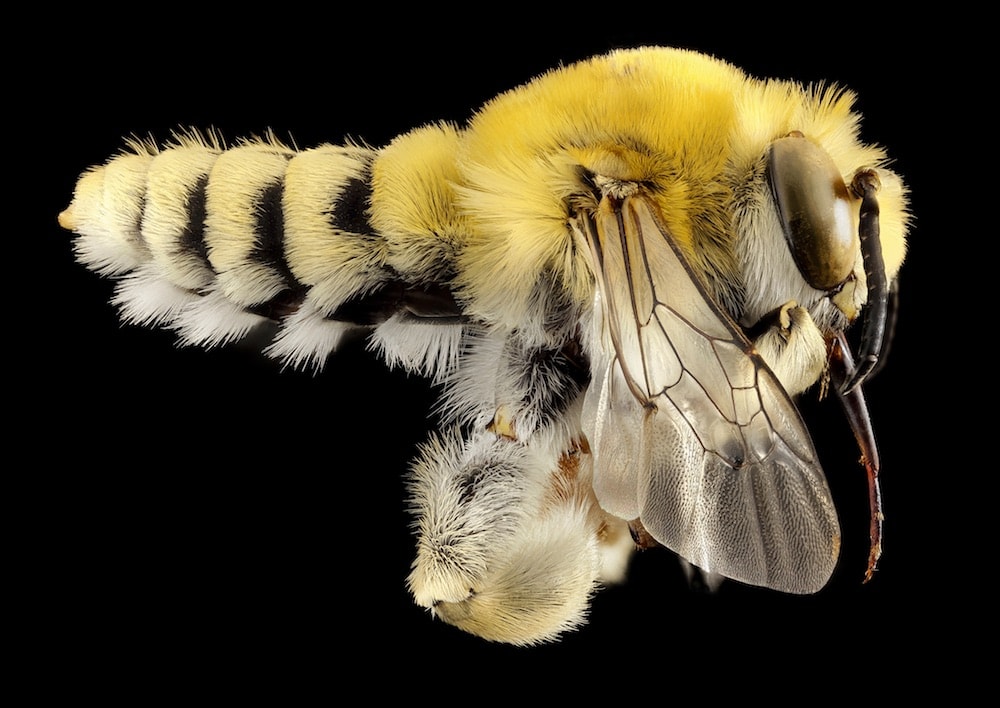
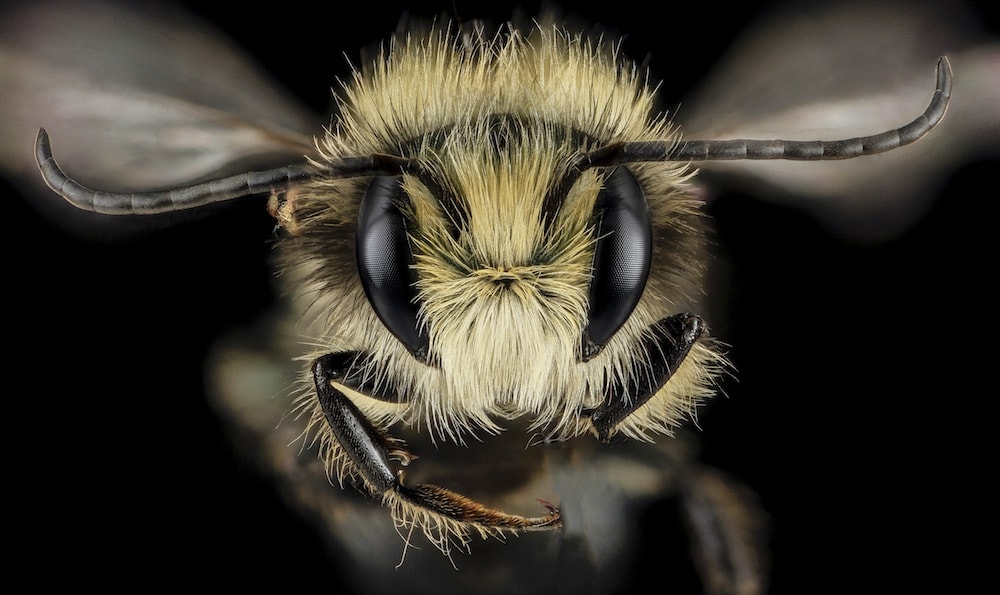
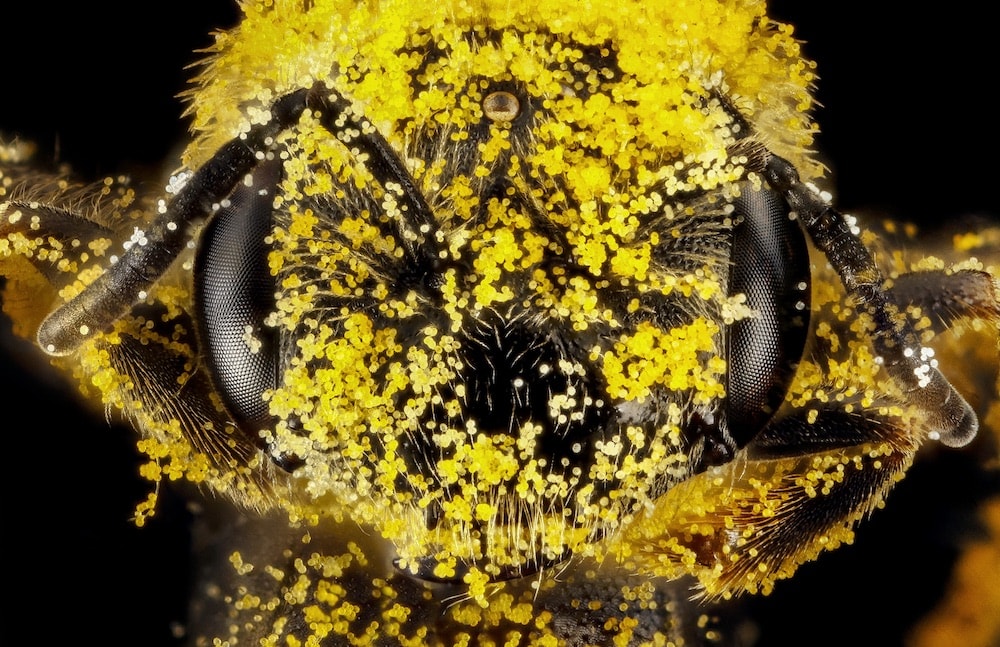
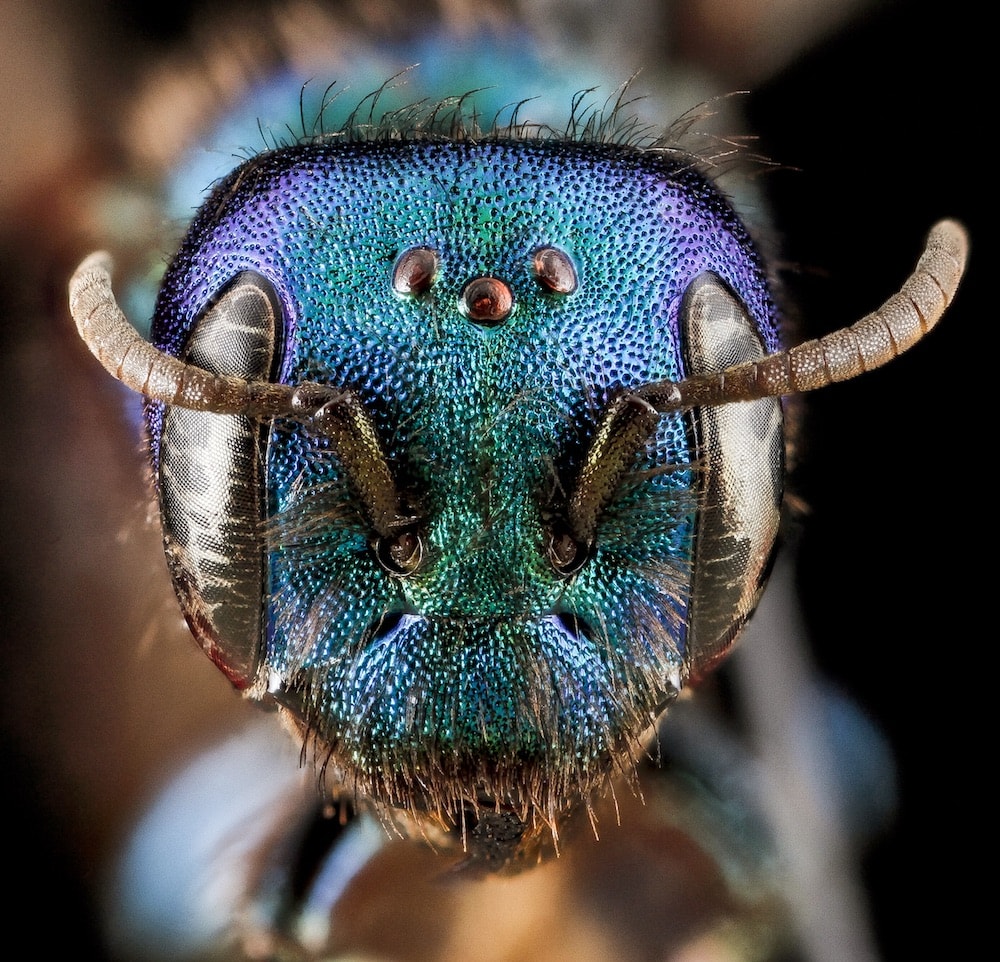
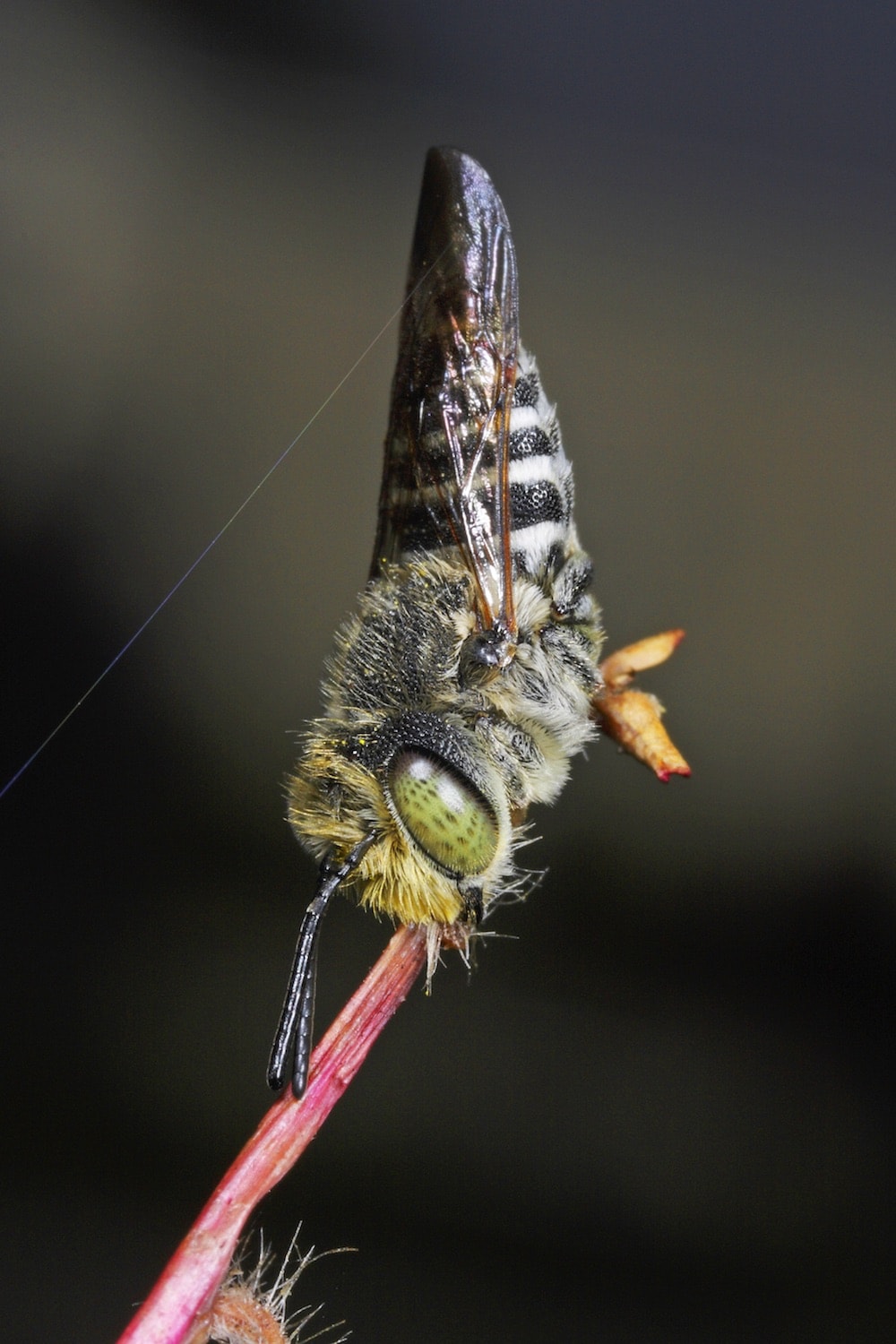
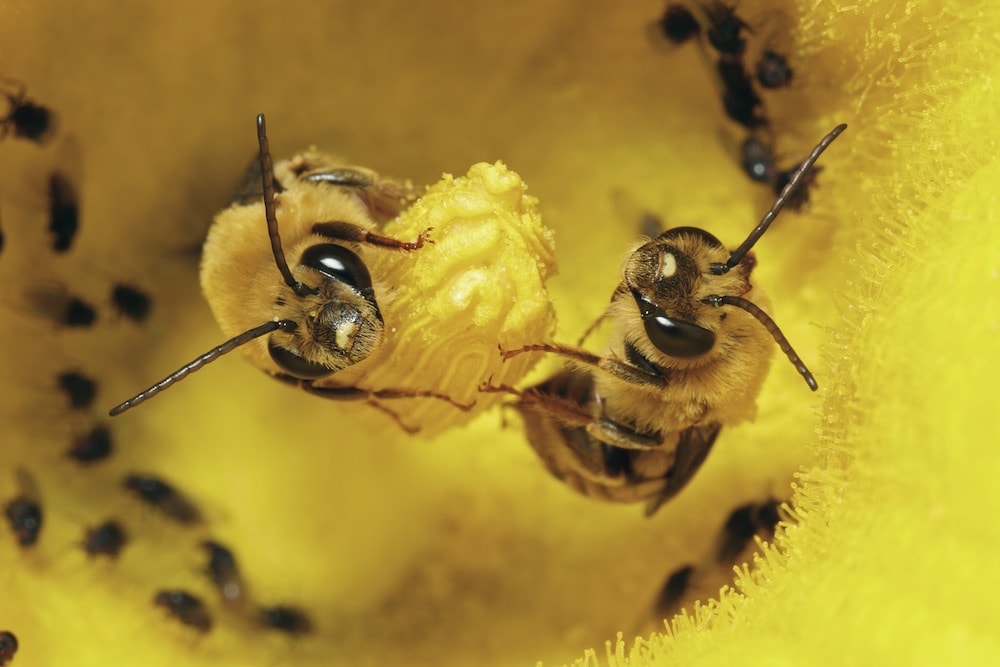
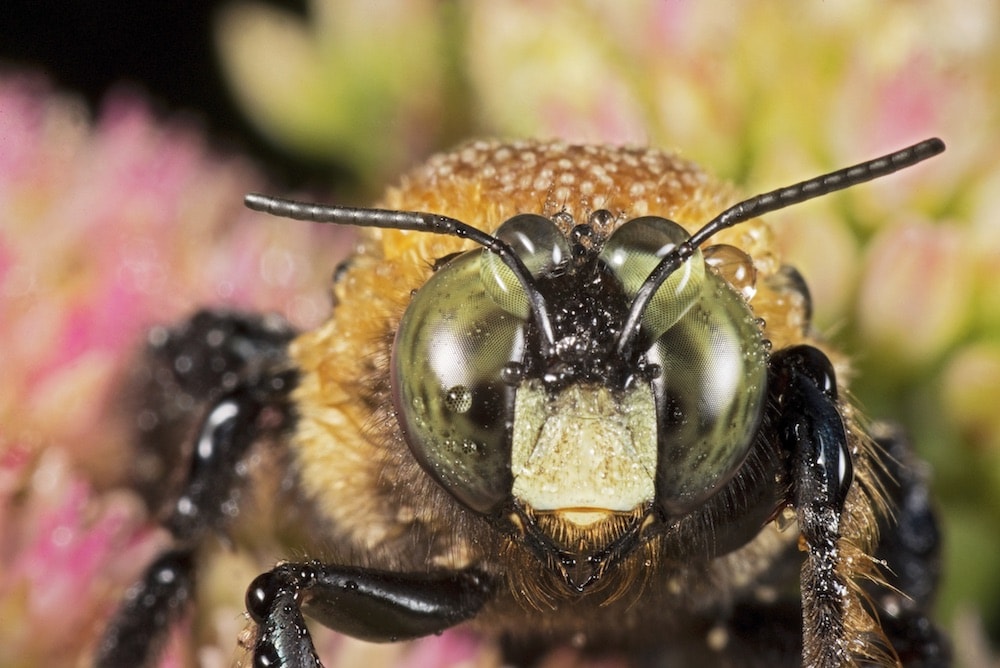
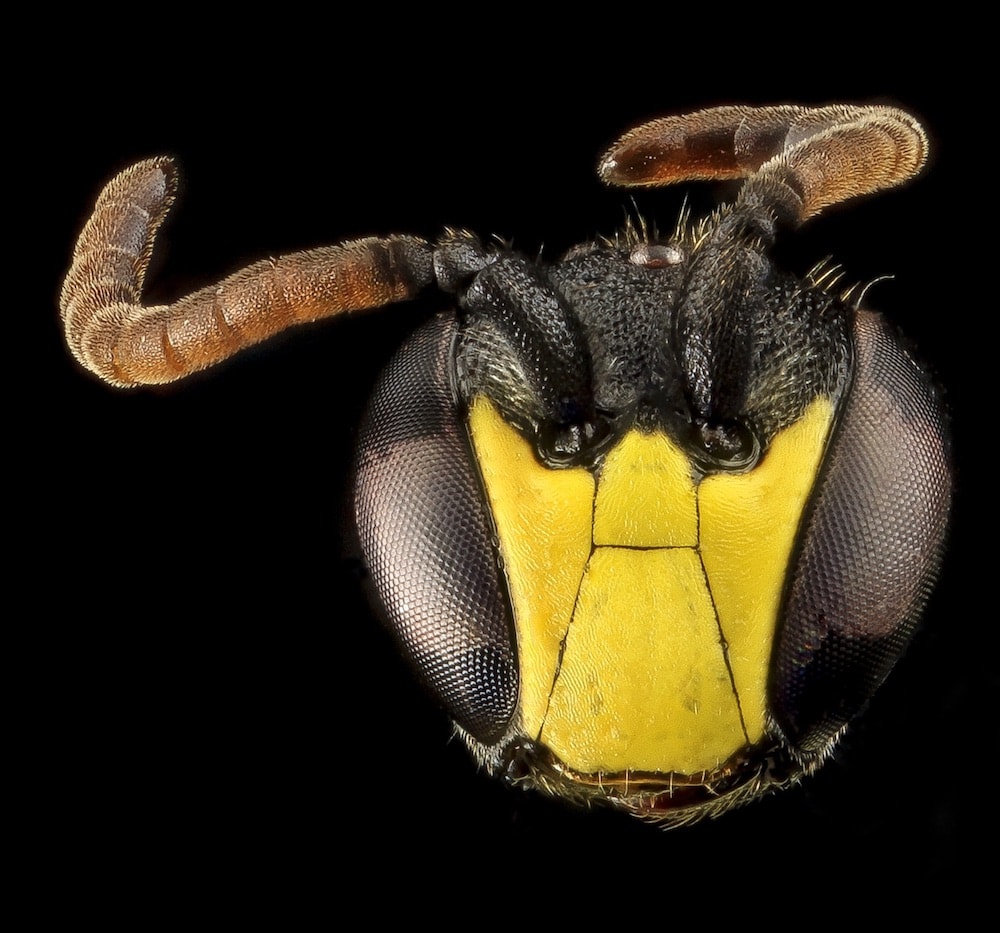
Invest in quality science journalism by making a donation to Science Friday.
Paige Embry is author of Our Native Bees: North America’s Endangered Pollinators and the Fight to Save Them (2018, Timber Press). She’s based in Seattle, Washington.
Susannah Lerman is a research ecologist with the USDA Forest Service based in Amherst, Massachusetts.
IRA FLATOW: This is “Science Friday.” I’m Ira Flatow.
Every year when I plant my garden, and it’s about now, I think about my tomato patch. What kind of tomatoes, how to stake them just right, the soil, you know, these kinds of things. But after all of these years of careful planting, I never once thought about the bees that would come and pollinate those little yellow flowers. I just took them for granted. But I was amazed to learn, reading my next guest’s book, that tomato flowers need to be vibrated to let loose their pollen. They call it buzz pollination.
And more amazingly, I learned that honeybees just aren’t good at that job. Bumblebees are truly where the buzz is at. Add to that the weirdos, I say that lovingly, of the bee world discussed in the book, bees that secrete silk or build towers, thieving bees that masquerade in other bees’ perfume. You might find yourself planning a wild bee stakeout around flowers this weekend to catch a glimpse of one of these native bees in action or mounting a bee house to your fence, like I’m going to be doing, to give these hiveless bees a home.
Let me introduce my guest. Paige Embry is the author of Our Native Bees, North America’s Endangered Pollinators and the Fight to Save Them. She joins us from KUOW. Welcome to “Science Friday.”
PAIGE EMBRY: Thanks for having me.
IRA FLATOW: What an eye-opening book this was. I think it’s just amazing, one bee fact after another. The fact about tomatoes and bumblebees just totally shocked me.
PAIGE EMBRY: Well, it shocked me when I learned it a few years ago as well.
IRA FLATOW: So how did you discover– what got you interested in studying these bees?
PAIGE EMBRY: So I have been a gardener for a long time, decades. And about five years ago, I learned that honeybees can’t pollinate tomatoes. And I was flabbergasted that I hadn’t learned it. I felt sort of dim, in fact.
But then I went and started asking other people. And none of them knew that honeybees couldn’t pollinate tomatoes, but that there were some native bees that could. Because honeybees aren’t native to North America. They came over from Europe with the early colonists. Honey and beeswax serfs, I guess.
And that’s what got me going on learning more about the bees that could buzz pollinate tomatoes. And there were so many of them. And they were nothing like honeybees.
IRA FLATOW: Wow. I think of honeybees as the workhorses of farms. But one thing you’ve been covering for Scientific American and the Food and Environment Reporting Network is the blue orchard bee– they call them BOB– developing them as a replacement for honeybees. Are they better pollinators? How difficult has it been? Will they get the job done?
PAIGE EMBRY: Ah! Well, whether they’ll get the job done, that’s a good question. They are certainly better pollinators. So if you think a hive box of honeybees has maybe 10,000 worker bees who go out and do the pollinating. And on an acre of almonds, for example, you would put two of those hive boxes. But you can replace one of them with just 400 female blue orchard bees. So they are much more efficient pollinators. The problem is, how do you raise enough blue orchard bees to make them useful in some of those big orchards?
IRA FLATOW: Mm-hmm. And we have an excerpt of the book up at sciencefriday.com/bees. And if you have any questions about bees or you’re looking to attract bees to your garden, give us a call, 844-724-8255, 844-SCI-TALK, or you can buzz us @scifri– I mean, tweet us @scifri, S-C-I-F-R-I. Sorry about that.
So how hard will it be to get these bees, the BOBs, out there? And then how will we know if they can do the job?
PAIGE EMBRY: Well, so, again, people have been working for decades to figure out how to manage blue orchard bees, because learning how to manage a new bee isn’t as straightforward as you might think. You’ve got to figure out how to manage enough of them and get them to the field at exactly the right moment when the plants are flowering. And so out of 20,000 species of bees worldwide, there’s only maybe a dozen or so that are managed.
And so with the blue orchard bees, again, the hard part is, how do you raise enough of them? And so people have been working on that.
IRA FLATOW: I understand from the book that The Wonderful Company, the big almond grower, was looking into the blue orchard bees. And then they discontinued that project because of what you’re saying.
PAIGE EMBRY: Yeah, what they did was– it was really cool. On 20 acres of land, they put up these giant net houses, like giant warehouses, and they filled them with flowers that had good pollen and nectar resources that the blue orchard bees loved. And then they would put the blue orchard bees in there and say, go forth and multiply. And their hope was to get a million female blue orchard bees off that 20 acres of land. And they thought they were going to get there in 2017, but they didn’t get their plants in in time, and so there wasn’t enough food.
And again, the guy who runs the project had hoped that they would get there this year in 2018, but Wonderful decided to close down the research project right before it was time to put the blue orchard bees out in the cages.
IRA FLATOW: Mm-hmm. Now, I understand that alfalfa fields are pollinated with another unusual bee, the alkali bee. Why is that?
PAIGE EMBRY: Well, they’re actually pollinated with two bees. One is the alkali bee, which is a native ground nesting bee, and another is called the alfalfa leafcutting bee. But the reason why they need those bees is that honeybees don’t like pollinating alfalfa. Because what happens when you land on an alfalfa flower, if you’re a bee, you trip the stigma and anthers so that they sort of pop up out of the flower and whap the bee upside the head.
IRA FLATOW: All right.
PAIGE EMBRY: And honeybees just don’t like that very much.
IRA FLATOW: Do you think honeybees get too much press? I mean, we don’t talk about these other bees that live solitary lives, that are not living in big hives making giant globs of honey that we’re eating.
PAIGE EMBRY: I absolutely think that the other bees deserve more press. A lot of them do a lot of pollination services for crops that they probably aren’t getting recognized for. And then there’s all of the other plants out there that they’re busy pollinating, and nobody even notices them.
IRA FLATOW: And you write about a lot of weird bee behaviors in your book. Some secrete silk, others shave fuzzy plants to make plush pillows for their eggs, some nest in snail shells? Really? An amazing cast of characters here.
PAIGE EMBRY: Again, that was one of the things I found when I started looking into these other bees. We all sort of tend to think of a bee as either a honeybee or just something with a stripey bottom that stings. But there’s all these bees, some of them smaller than a grain of rice, some are beautiful, beautifully colored with iridescent exoskeletons, and then they have all these behaviors. So they’re a really diverse group of animals. And we sort of shoehorn them into this word that we call a bee.
IRA FLATOW: Speaking of bee-haviors, you write there are parasitic bees, bees that lay their eggs in other bees’ nests. How do they get away with that?
PAIGE EMBRY: Ah! Ha, ha, ha. Yeah. Well, I asked the guy who is sort of the expert on those bees. They’re called cleptoparasites. And what happens is rather than gathering pollen and nectar for their babes themselves, the mother bees slide into the holes of another bee’s nest and lay their eggs in there.
So I asked the guy who’s been studying these bees. I’m like, well, how come the mother bee who was making the nest doesn’t know and do something about it? And he said, well, it’s dark in there, and they don’t have a flashlight.
IRA FLATOW: That’s a great answer. Well, that’s a great cue. Let’s get some more questions. Our number, 844-724-8255. Scott in Reno. Hi. Welcome to “Science Friday.”
SCOTT: Thank you so much for taking my call. I love the show.
IRA FLATOW: Thank you. Go ahead.
SCOTT: All right. So we have a garden now. And we live in Reno. So it’s really, really dry here. And I was wondering what kind of flowers we could plant that would actually grow and what kind of bees are around here that those flowers would attract.
PAIGE EMBRY: OK. So some of the best bee diversity certainly is in the dry parts of the southwestern United States. I can’t speak specifically to Reno. But again, there tend to be a lot of bees.
So what I would do would be to look to– my answer always when people ask me what to plant at some place I don’t know well is go out for a walk and look around on a day when it’s maybe above 55 degrees, there’s not much wind, the sun is out, and see which plants the bees are visiting. And if you don’t know that plant, then you can take a picture of it and hopefully find it on the web or take it to a local nursery.
If you were willing to do some irrigation, clearly, you would have more. But if you want to stick with native drought-tolerant plants, then that take a walk idea is the best one I’ve got.
IRA FLATOW: All right. Thanks for calling. And you do point out in your book, as you have said in passing, that bees do like to live in these dry, arid places in the ground if not in flowers.
PAIGE EMBRY: Well, so we think, again, of honeybees nesting in a hive and maybe in a tree somewhere or in a hive box. But most bees nest in holes in the ground. And so you need to have places for those bees to nest in holes in the ground. And others nest in, like, old beetle burrows or inside pithy stems like blackberry or elderberry. So there’s all sorts of places. Or, as you pointed out, there’s the ones that nest in the snail shells or dung patties or all sorts of surprising places.
IRA FLATOW: Here’s a tweet coming in. It says, I’ve seen bee houses made of small reeds. You set them on the ground for native bees in use. Do they really work? Wouldn’t other insects take them over?
PAIGE EMBRY: They certainly work. I don’t know about setting them on the ground. Usually, they’re sort of put up on the side of a house or sort of up in the air a little bit. And there are some other insects that will also nest in there, but they’re usually desirable insects. So if you have different sized reeds, you can get a variety of bees and some of the little wasps that are desirable as opposed to yellow jackets or hornets or something along those lines.
IRA FLATOW: Well, Lynn Brunelle, who’s a great author of stuff to do about science, she has a new book out. And when she talks about how you can make a bee house by taking a pop bottle, cutting it in half, and just putting the straws– just putting straws in it, hanging it up.
PAIGE EMBRY: Yep.
IRA FLATOW: And how do the bees occupy that place? What do they do with those little holes?
PAIGE EMBRY: So what happens is the bee will– the female bee, because she’s the one that lays the eggs and does all the baby work, she goes and collects nectar and pollen from a flower. And she usually has to make several trips. And she’ll make a little wad of that mixture, and she’ll lay an egg on it. And then she closes that egg off from the rest of the hole, maybe with a wall of mud or chewed up bits of leaves or there’s a whole variety of things.
So she closes each egg in its little food wad off. And then she just starts over again, and sort of fills in that hole. So sometimes with some of those reeds or tubes, you can tell that they’re full of baby bees, because you’ll see a little wall at the very end of the tube.
IRA FLATOW: Wow. Cool, as they say. I’d like to bring on another guest now who has the secret to attracting more native bees to your yard. And she says stop mowing the lawn every week. Her study’s out in the journal Biological Conservation. Susannah Lerman is a research ecologist with the USDA Forest Service in Amherst, Massachusetts. She joins us from New England Public Radio. Welcome to “Science Friday.”
SUSANNAH LERMAN: Thanks for having me on.
IRA FLATOW: So I shouldn’t be mowing my lawn every week.
SUSANNAH LERMAN: That’s right. So I wanted to figure out other ways that we can help bees. And I think a lot of the listeners probably have heard about the plight of bees. A lot of their habitat has been taken away or altered from urban development. But when we look in our cities and suburbs, we see that there’s actually a lot of flowers that are still present in places like community gardens, on meadows, or in pollinator gardens in people’s backyards.
But I wanted to see whether or not bees could also be attracted to the biggest area of green spaces in these areas, which are lawns. Lawns cover something like 65,000 square miles. So to put that in perspective, that’s roughly the size of Florida. And a lot of my colleagues have really dismissed lawns as non-habitat. Because you look at a lawn, and it’s just grass. It’s very low. There’s no structure to it.
But I kept thinking, well, there’s so much lawn available. How do we make these lawns less bad? And so really trying to figure out, are there ways that we can manage these lawns so that they can provide bee habitat?
IRA FLATOW: Mm-hmm. Our number, 844-724-8255. You can also tweet us @scifri. In case you’re just joining us, this is “Science Friday” from PRI, Public Radio International.
We’re talking about bees this hour and about bees you’ve probably never heard of. My guests are Paige Embry, author of Our Native Bees, North America’s Endangered Pollinators and the Fight to Save Them, Susannah Lerman, research ecologist with the USDA Forest Service in Amherst, Massachusetts.
So if you mow your lawn every other week, your study found that you can have a good survival rate for bees in the lawn?
SUSANNAH LERMAN: Yeah, so we found that when you mow your lawn less, you have more lawn flowers. So these are these, what we call these unsung heroes for conservation, these dandelions and clover and yellow woodsorrel, horseweed, all of these what I think some people might consider these weeds, but they actually seem to be providing some nectar and pollen sources for bees.
And so we wanted to see whether we mowed less, do you have more flowers? And if you have more flowers, do you have more bees? And so we found that, yes, indeed, you mow less, there’s more flowers. But it’s when you mow every two weeks, that’s kind of the sweet spot for when you have the most bees.
IRA FLATOW: Paige, you mention in your book about how people are working with golf courses to turn them into preservation areas for the habitat there.
PAIGE EMBRY: Yeah, there are a number of groups that are looking to build pollinator to habitat on golf courses. And it’s not where you would be mowing less, but more taking some of those areas that are not actually used for golf, and rather than just having them be sort of rough and grass, to actually plant flowers there for them.
There’s also some folks who are up in Minnesota who are working on sort of a lawn seed mix, where they’re adding flowers to grass as well. So sort of along the same ideas of putting flowers back in actual lawns.
IRA FLATOW: Mm-hmm. You write that managed bees, like honeybees, can suck up all the pollen if you put down a bunch of beehives, and leaving little for the wild bees.
PAIGE EMBRY: Yeah, there was a study done. A lot of times after the pollination season is mostly done, the beekeepers will want to have someplace good to put their bees. And when you put down dozens, maybe, of colonies of honeybees with 10,000 or more bees in them, they use a lot of the resources. So they sort of calculated just how much resources they were using. And it would take a lot from a lot of solitary and local wild bees.
IRA FLATOW: Mm-hmm. Let me see if I can get a quick phone call before the break. Let’s go to Jupiter, Florida. Hi, Adriana.
ADRIANA: Hi! How are you?
IRA FLATOW: Hi, there. Go ahead.
ADRIANA: Wow. This is exciting. OK. I just wanted to share something. Maybe you can speak on it. I think you probably did a little bit already.
I planted a avocado tree from seed. And it’s– actually, after eight years, it’s flowering for the first time. I’m very excited. So I got close, and I noticed there’s some bees on there. So of course, I had to go take some pictures up close. And as I’m looking around, I realize there are a tremendous variety of bees on there. There was your regular little [INAUDIBLE] bee sort of doing its thing. And then there was a green one with a big red [INAUDIBLE].
IRA FLATOW: Oh, I think we–
ADRIANA: Looked like wasps. And it was just amazing–
IRA FLATOW: All right. Let me get–
ADRIANA: –amazing, the–
IRA FLATOW: Yeah, let me just get a reaction from our experts before we go to the break here. There are a lot more bees out there than people think there are, or are they not, Susannah?
SUSANNAH LERMAN: Yeah, absolutely. So we identified 111 different species that were using our lawns.
IRA FLATOW: Wow!
SUSANNAH LERMAN: So this is in 16 yards in Springfield, Massachusetts. So in suburban areas, these are lawn dominated yards. So these yards didn’t have pollinator gardens or special plants to attract bees. And so that’s roughly a quarter of all bees that have been recorded in the state. And so there’s a lot going on in these yards when you start looking for them.
IRA FLATOW: Well, we’re going to be right back after the break and talk more about all the different kinds of bees out there. 844-724-8255. You can also– ooh, lots of tweets coming in @scifri. We’ll be right back after the break. Stay with us.
You’re listening to “Science Friday.” I’m Ira Flatow. We’re talking this hour about North America’s wild bees, not the honeybees that are in nests and in hives. We’re talking about bees that make nests all over the place with my guests Susannah Lerman from the USDA Forest Service, Paige Embry, author of Our Native Bees.
Paige, it’s a great book. It’s terrific. And beautiful photos in there. Plates of stuff that you’d never seen before.
Our number, 844-724-8255. Let me go to some tweets that have come in. And I’m just going to go through them. And we’ll try to pick off as many as we can.
Tweet from Moore Square Garden Club. Will flowers planted in a garden really attract more bees or can that reduce fruit produced? Hmm.
Someone is seriously concerned about the lack of pollinators in north Alabama. What do you suggest individuals do to promote them?
And then this last one. Enjoying the discussion of bees. I planted fig trees last year and learned about the wasps. Could you talk about bees versus wasps?
And Susannah, can you talk about them? What is the difference?
SUSANNAH LERMAN: So actually, I’d like to answer the question from Alabama.
IRA FLATOW: OK.
SUSANNAH LERMAN: Because I think in terms of things that people can do– and this kind of builds on some of the work that Paige was talking about in her book about golf courses and planting pollinator gardens. So that’s one thing that everybody can do.
But for those of us who don’t have the time or the money or the green thumb, another way that we can contribute to providing for bees is to mow our lawns less. And so I think this is something that you don’t have to do. In our paper we call this the lazy lawnmower approach. And I think for a lot of people who want to do something good, but don’t have the time, this might resonate for them. And so that’s another thing that we can put in our tool box.
IRA FLATOW: But up here in the Northeast where Lyme disease was invented, so to speak, we keep hearing that if you don’t mow your lawn down, the ticks are going to be all over the place.
SUSANNAH LERMAN: So that’s really interesting. So another thing that we looked at, but we didn’t publish it in our paper, was we did tick checks in all of our lawns that we worked in. And in the yards that were mowed every week, every two weeks, and every three weeks, and we saw absolutely zero ticks.
And that’s not to say that ticks aren’t around. They are, especially in areas that where yards might abut more forested areas or wood lots. But at least in some of these yards in Springfield, Massachusetts, we didn’t find any ticks. So that wasn’t a problem.
IRA FLATOW: Let’s go to the phones, because we have lots of calls. Tom from Hot Springs Village, Arkansas. Welcome to “Science Friday.”
TOM: Hi, there, Ira–
IRA FLATOW: Hi, there. Go ahead.
TOM: –and Susannah.
SUSANNAH LERMAN: Hiya.
TOM: Hey, I have a question about what you’re feeling is about the use of neonicotinoids on nursery plants.
IRA FLATOW: OK. Go ahead. Would you like Susannah or Paige to talk about that?
SUSANNAH LERMAN: Paige, do you want to take this one?
PAIGE EMBRY: This is not someplace that I went down for the book, because it was a big rabbit hole to be jumping down. So actually, I can sort of pass that one on to you. I will say with respect to the neonics is that because it’s such a different kind of pesticide from the one we’re used to where the pesticide gets sprayed on the surface of the plant, but with neonics it’s taken up by the cells and moved throughout the plant, that it has been found in pollen and nectar. But perhaps you have some more information on that?
SUSANNAH LERMAN: I think I’m going to take the same pass as you.
IRA FLATOW: This is a very controversial subject, is it not? About colony collapse. These mostly talk about honeybees instead of– we very rarely talk about wild bees when we talk about neonics.
SUSANNAH LERMAN: Right. And also, for my research, we really were looking at these spontaneous plants that were already growing in the lawns. So none of these lawns had any sort of chemical inputs on them. So we weren’t addressing that issue.
IRA FLATOW: Let’s go to Jan in Memphis who has an interesting story about something that Paige did cover in her book. Jan, go ahead.
JAN: Yes. Hi. Thank you for having me on your show. We have a problem with carpenter bees, I guess that’s what they’re called. They bore into the side of your house. Are they pollinators?
PAIGE EMBRY: They are absolutely pollinators. And I was just in the Southeast. Where I live in Seattle, we don’t have the large carpenter bees. So it’s not a problem I’ve personally dealt with. But I think every place I went and everybody I talked to was concerned about those bees. And one of the questions was, are they pollinators? And they are absolutely pollinators. And there’s some of the native plants that they pollinate and a whole variety of other plants. So they’re good pollinators.
IRA FLATOW: They’re great drill bits, too. I mean, they bore a perfect hole right into my mailbox post, like, perfect, like I had taken out a drill myself and done it. But you say in your book, they will not attack painted surfaces. Is that correct?
PAIGE EMBRY: Well, I have been told that they definitely attack painted surfaces.
IRA FLATOW: Oh, they do.
PAIGE EMBRY: But they tend to prefer surfaces that are unpainted. So one of the things that you might be able to do is to paint and see. And then maybe provide them with some other place that they can go that might have some nice desirable unpainted wood instead. So maybe they’ll choose that.
IRA FLATOW: All right, so coming full circle now, back to my tomato patch, which I talked about at the beginning, how do I attract the bumblebees that I’m going to need to get those little yellow flowers working?
PAIGE EMBRY: Well, I can think of two good things. One thing is a bumblebee queen overwinters in a little hole living on her fat for the winter. And so she comes out in early spring or mid-spring and she needs food right then. And so this is before the tomatoes come out. So you’re going to want to have flowers in your garden sort of in the springtime for those bees that come out of their winter’s hibernation-like state really hungry. So you want those queens to do well, so they’ll build up lots of daughters, so there’ll be lots of bees available for your tomatoes.
And the other thing, again, is tomatoes only have pollen. They don’t have nectar. And so you’re going to want to have a lot of other plants around, so that they can get both nectar and pollen. And they like to have a balanced diet. They’re generalist bees. So they like to get pollen from other plants as well.
IRA FLATOW: Susannah, what is most fascinating to you about bees? You’ve been studying them.
SUSANNAH LERMAN: To me, I think that there are so many. And so I had a quick look in Paige’s book and was just fascinated by all the different colors and shapes of these bees. And I hadn’t really thought about them before I started this study. But now realizing that they’re buzzing all around and, again, you don’t know what’s going to happen in these areas.
But also, that for many people, this is a way that they can connect with nature. There’s bees– there’s wildlife in their backyards. And so I think by doing exploration in these yards, it’s really letting people know that their yards have a role to play, and they can go out and experience these wild animals.
IRA FLATOW: And, Paige, for those of us who thought that honeybees were what’s out there, just look through the gorgeous pages of your book. And we have photos of the unusual bees up at our website at sciencefriday.com/bees.
It’s just really eye-opening to see how many different and wild and wonderful different kinds of bees there are.
PAIGE EMBRY: It is. And when you go out in your yard and you really start looking, you’ll see them. And it’s like they’ve been there all along. And they’re there. And it’s so fun when you plant a plant, a specific plant, thinking, this is going to be good for bees. And you go out and they’ve come. It’s like the easiest conservation ever.
IRA FLATOW: Well, I’m going to do it this weekend and try to get my bee house up this weekend. Susannah Lerman, a research ecologist with the USDA Forest Service in Amherst, Massachusetts, Paige Embry, author of Our Native Bees, North America’s Endangered Pollinators and the Fight to Save Them. Thank you both for taking time to be with us today.
PAIGE EMBRY: Thanks very much.
SUSANNAH LERMAN: Thank you, Ira.
Copyright © 2018 Science Friday Initiative. All rights reserved. Science Friday transcripts are produced on a tight deadline by 3Play Media. Fidelity to the original aired/published audio or video file might vary, and text might be updated or amended in the future. For the authoritative record of Science Friday’s programming, please visit the original aired/published recording. For terms of use and more information, visit our policies pages at http://www.sciencefriday.com/about/policies/
Christopher Intagliata was Science Friday’s senior producer. He once served as a prop in an optical illusion and speaks passable Ira Flatowese.